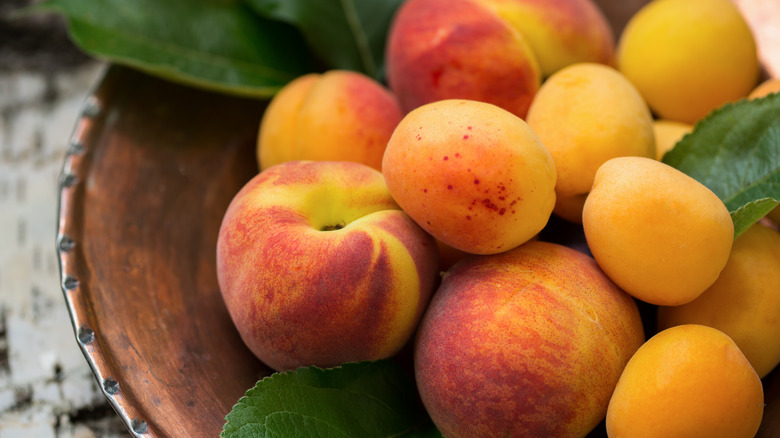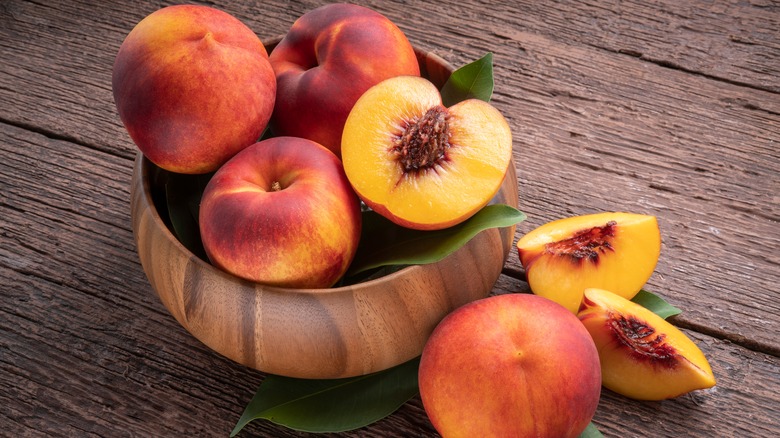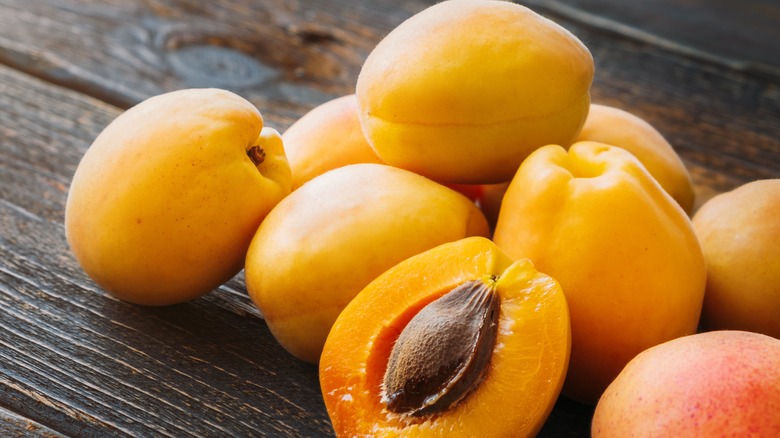Peaches Vs. Apricots: What's The Difference?
There's nothing like stone fruit season. It's that wonderful time of year when you can walk into the grocery store, or over to the fruit stand and catch a whiff of summer. Most people have their favorite kind of stone fruit, and whether you enjoy eating them fresh, making baked goods with them, putting them in your salad, or even adding them to the grill, they're bound to leave an impression.
When looking at stone fruit like nectarines, peaches, plums, and apricots there are two varieties that you might assume are related. Both peaches and apricots have similar coloring and texture to their skin. Their fuzzy exterior differs from the smooth-skinned plum or smooth-skinned nectarine. Yet, aside from the color and fuzziness, peaches and apricots have some stark differences and some interesting similarities.
Peaches are larger and usually sweeter
Both peaches and apricots come from the rose family and are actually closely related to almonds, apples, and pears. While peaches and apricots are cousins, there are some differences that make them each unique, like the fact that they are in fact different species.
Peaches are much larger than apricots — about four times as big — and they come historically from Persia (modern-day Iran). Peaches also tend to have more water inside their flesh which gives them their signature juiciness. Peaches tend to be sweeter than apricots as they have a higher sugar content, and their pit is jagged and rougher in texture than the pit of the apricot.
When preparing peaches in the kitchen, they can be deliciously enjoyed on their own, but they're also wonderful grilled, or sliced and baked in a peach cobbler or peach pie. Additionally, they are delicious in a summer salad and can offer that sweet, fresh vibe that pairs nicely with earthy greens or rich cheeses. In the U.S., California is one of the main producers of peaches, followed closely by South Carolina.
Apricots are small and slightly tart
Apricots are not only smaller than peaches but they also have a different flavor than their cousin the peach. Historically, apricots are thought to be from either Armenia or China, but today Turkey is one of the biggest producers of the fruit. They thrive in more arid climates and in the U.S., California is one of the major producers.
These small stone fruits have less water than their bigger cousin the peach, and they are also much more tart in flavor. Apricots are higher in a compound called malic acid, which gives this fruit a more tart flavor, instead of just a sweet one. For this reason, you might want to wait until an apricot is fully ripe before eating it fresh.
An apricot's natural sweetness also comes out more when the fruit is cooked down to make tarts, jams, and jellies, or when they are dehydrated and dried. When eaten fresh, expect a zippy tartness in the fruit. If you're planning to substitute apricots in place of peaches in a recipe, you'll need to be cognizant about adding a bit more sweetness and even more liquid since peaches have more of both.


